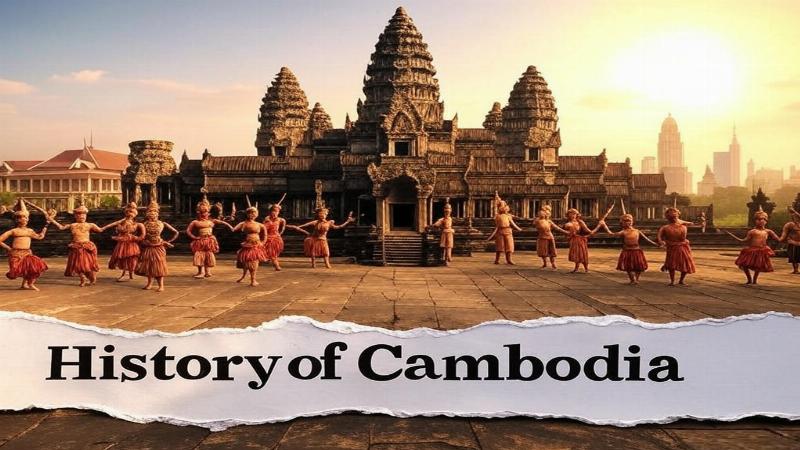Place for ads

Cambodia, a lush nation in Southeast Asia, is a land where ancient temples rise from jungles and rivers weave through a turbulent past. Covering 181,035 square kilometers, it sits between Thailand, Laos, Vietnam, and the Gulf of Thailand, its Mekong Delta nurturing its soul. Known today for Angkor Wat, resilience, and vibrant markets, Cambodia’s history blends the grandeur of empires, colonial shadows, and modern rebirth. In this article, we’ll journey through Cambodia’s past, from its earliest days to its contemporary identity, uncovering the milestones that have shaped this captivating country.
Cambodia’s human story begins around 40,000 BCE, with hunter-gatherers roaming its plains—stone tools from Laang Spean Cave in Battambang date to this era. By 4200 BCE, Neolithic settlers farmed rice near the Tonle Sap, leaving pottery and hoes—some of Asia’s oldest—at Samrong Sen.
The Bronze Age (1500 BCE) brought metallurgy—bronze drums at Memot hint at trade with Vietnam’s Dong Son culture. Iron Age tribes (500 BCE) smelted tools, while Mon-Khmer peoples migrated south, ancestors of today’s Khmer majority. These early communities thrived on fish and rice, laying Cambodia’s ethnic roots.
By the 1st century CE, Funan emerged as Cambodia’s first state—a
Place for ads
Funan faded by the 6th century, succeeded by Chenla—centered in Sambor Prei Kuk. King Isanavarman I (616–635 CE) unified the region, his inscriptions boasting conquests. By the 8th century, Chenla split into “Land” and “Water” factions, weakening until Jayavarman II’s rise heralded a golden age.
In 802 CE, Jayavarman II declared himself “god-king” on Phnom Kulen, founding the Khmer Empire—Angkor was born. His successors, like Yasovarman I, built Angkor Wat under Suryavarman II (1113–1150), a Vishnu temple of unmatched scale. The empire stretched from Vietnam to Thailand, its canals feeding millions.
Jayavarman VII (1181–1218) crowned Angkor’s glory—Bayon’s smiling faces and Ta Prohm’s tree-clad ruins reflect his Buddhist reign. Trade with Song China thrived—silk for sandstone—until the 14th century, when drought, Thai raids, and internal strife toppled Angkor by 1431, shifting the capital south.
Post-Angkor, Cambodia shrank—Phnom Penh rose in the 15th century as a trade hub on the Mekong. Thai and Vietnamese neighbors encroached—Ayutthaya sacked Lovek in 1594, while Annam vassalized the east. Kings like Chey Chettha II (1618–1628) balanced powers, but Cambodia became a pawn.
The 17th and 18th centuries saw chaos—civil wars and puppet kings drained the land. European traders—Portuguese, Dutch—passed through, but Spain’s brief 1590s occupation fizzled. By the 19th century, under King Ang Duong (1841–1860), Cambodia sought French protection to fend off Siam and Vietnam.
In 1863, King Norodom I signed a protectorate treaty with France—Cambodia joined French Indochina by 1887. Phnom Penh’s Royal Palace gleamed, but rubber plantations and taxes bled the countryside—rice fields fed Saigon. France restored Angkor Wat, yet Khmer culture waned under Parisian rule.
World War II shook control—Japan occupied in 1941, forcing King Norodom Sihanouk’s 1945 independence bid. France reclaimed it post-war, but nationalism grew—Sihanouk’s 1953 campaign won freedom. On November 9, 1953, Cambodia emerged sovereign, ending 90 years of colonial yoke.
Sihanouk abdicated to lead as prince—his Sangkum party modernized schools and roads, dubbing the 1950s–60s a “Golden Age.” Neutral in the Cold War, he juggled U.S. and Soviet aid, but Vietnam War spillovers destabilized the east—Viet Cong hid in Cambodia, irking Washington.
In 1970, Gen. Lon Nol’s U.S.-backed coup ousted Sihanouk—civil war erupted as Khmer Rouge guerrillas, led by Pol Pot, gained ground. Lon Nol’s Khmer Republic crumbled—corruption and U.S. bombs (600,000 tons) alienated peasants, paving Pol Pot’s path to power.
On April 17, 1975, the Khmer Rouge seized Phnom Penh—Year Zero began. Pol Pot’s agrarian utopia emptied cities—2 million marched to fields. Money, schools, and religion vanished—Tuol Sleng prison tortured 20,000; 1.7 million died from starvation, disease, or execution by 1979.
Vietnam invaded in 1978, toppling Pol Pot—Phnom Penh fell January 7, 1979. The People’s Republic of Kampuchea rose, but Khmer Rouge fought on from Thailand. Sihanouk, exiled, rallied a UN-backed coalition—peace teetered until the 1991 Paris Accords ended war.
The 1993 UN election restored Sihanouk as king—Hun Sen’s CPP shared power, dominating since 1997. Pol Pot died in 1998; trials convicted leaders like Duch in 2010. Today, Cambodia’s 16 million people rebuild—Phnom Penh buzzes, Siem Reap thrives on Angkor tourism.
Garments and rice drive growth—poverty halved since 2000—but corruption and land grabs persist. Culture shines—Khmer dance, apsaras, and silk weaving endure. Hun Sen’s 2023 exit to son Hun Manet hints at change, though democracy wavers.
Cambodia’s history is a Southeast Asian epic—from Angkor’s spires to Khmer Rouge ashes, independence to fragile hope. Its rivers murmur of ancient might, its people pulse with grit. As Cambodia strides forward, its past fuels a legacy of beauty and bravery.
Place for ads